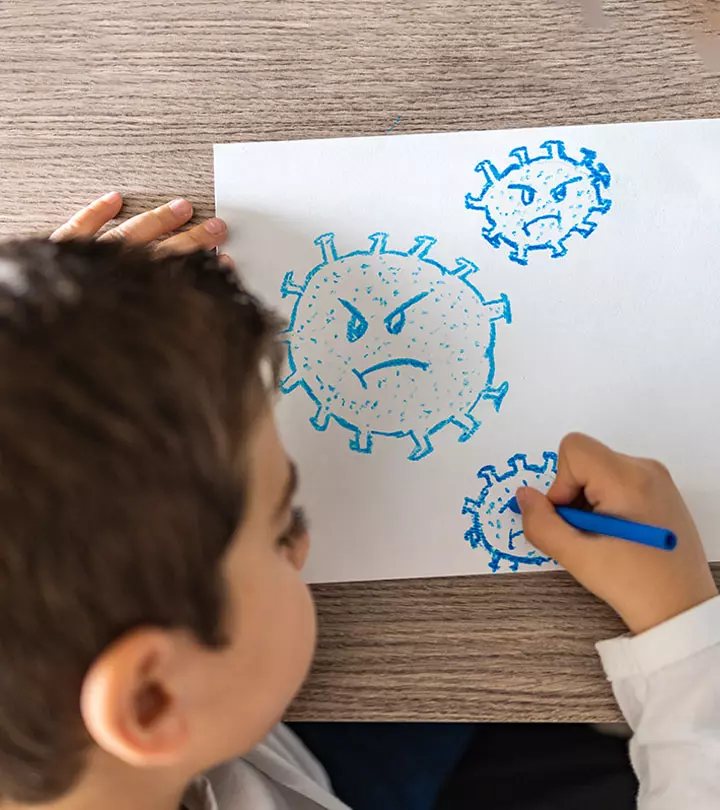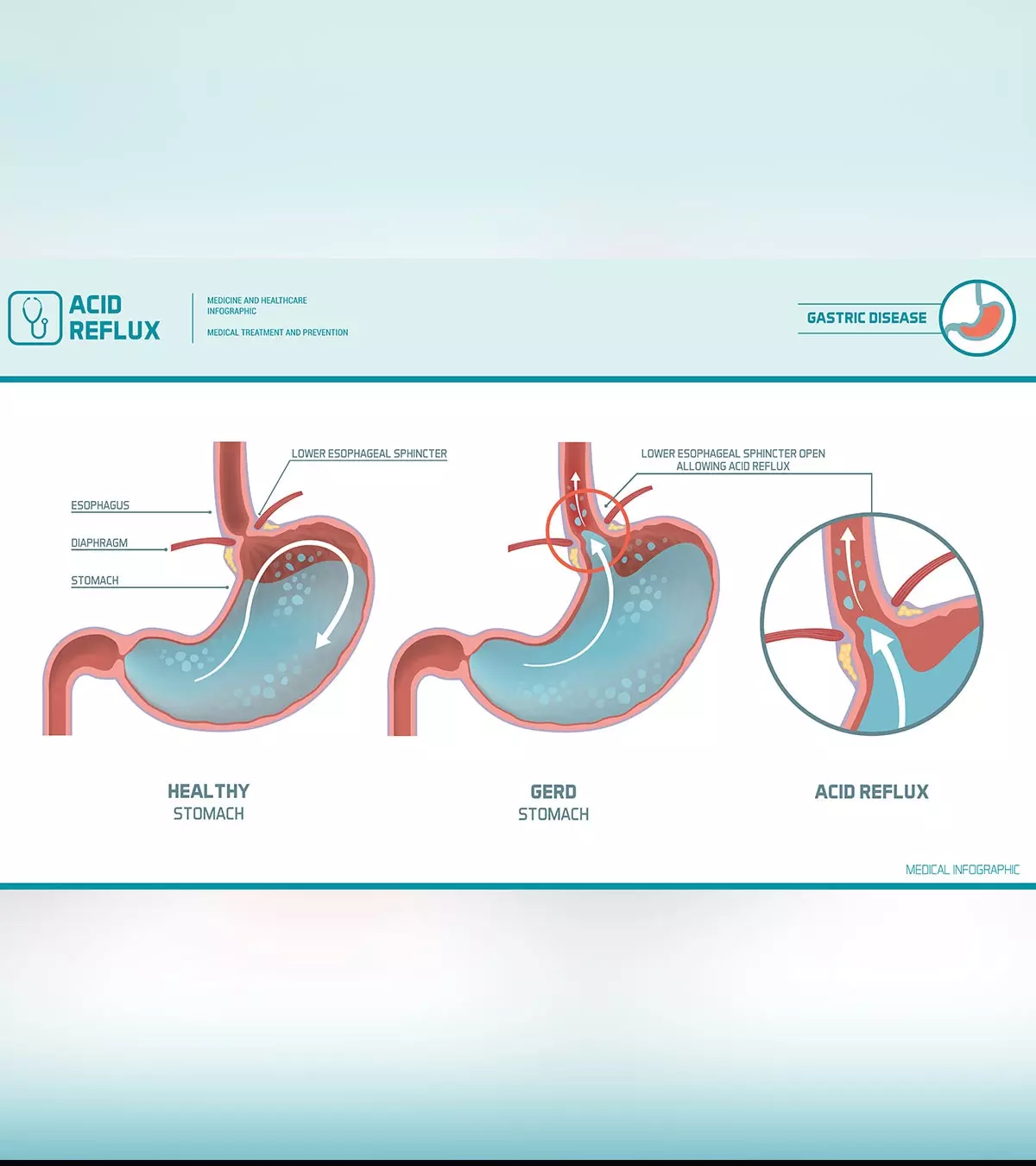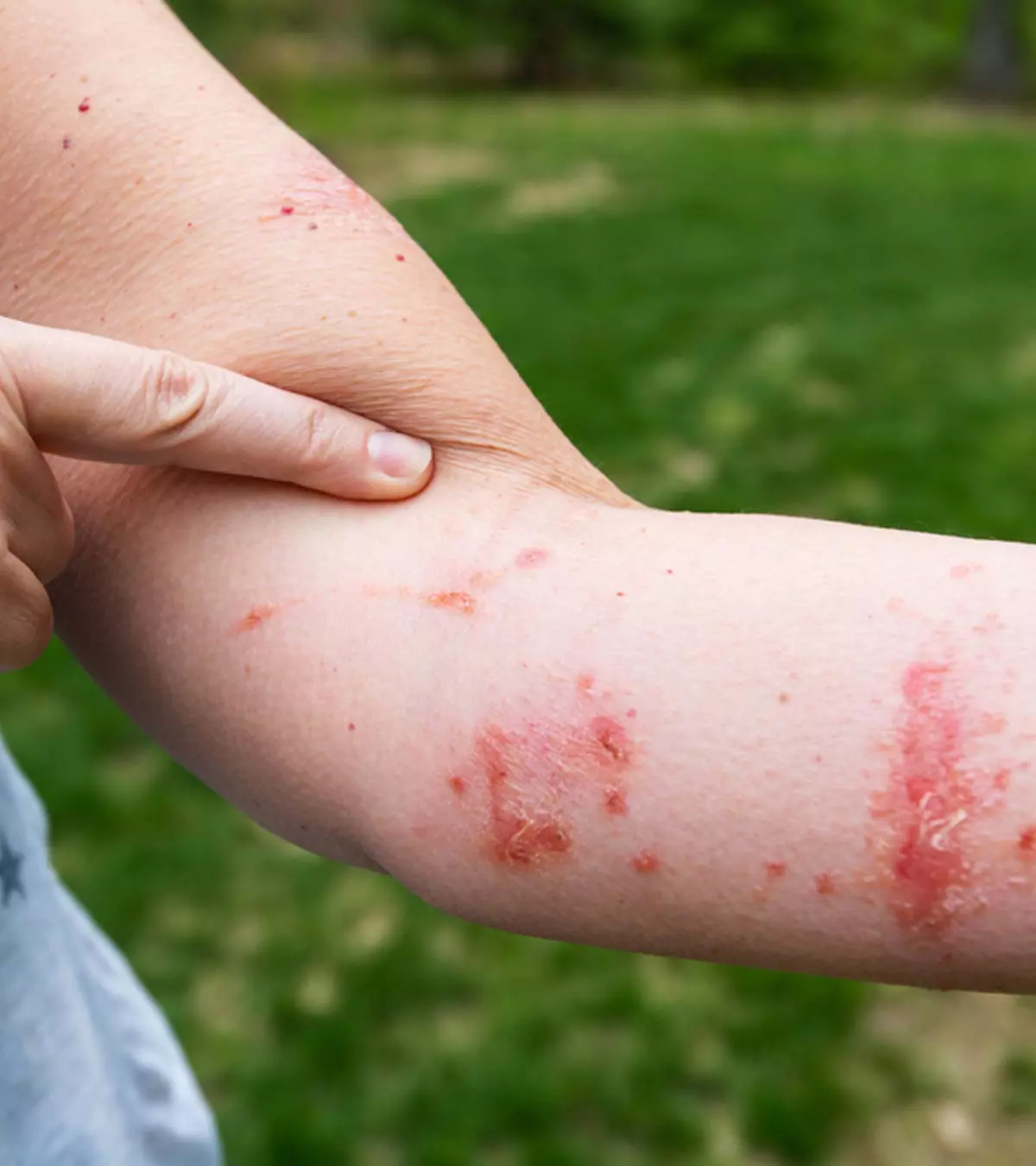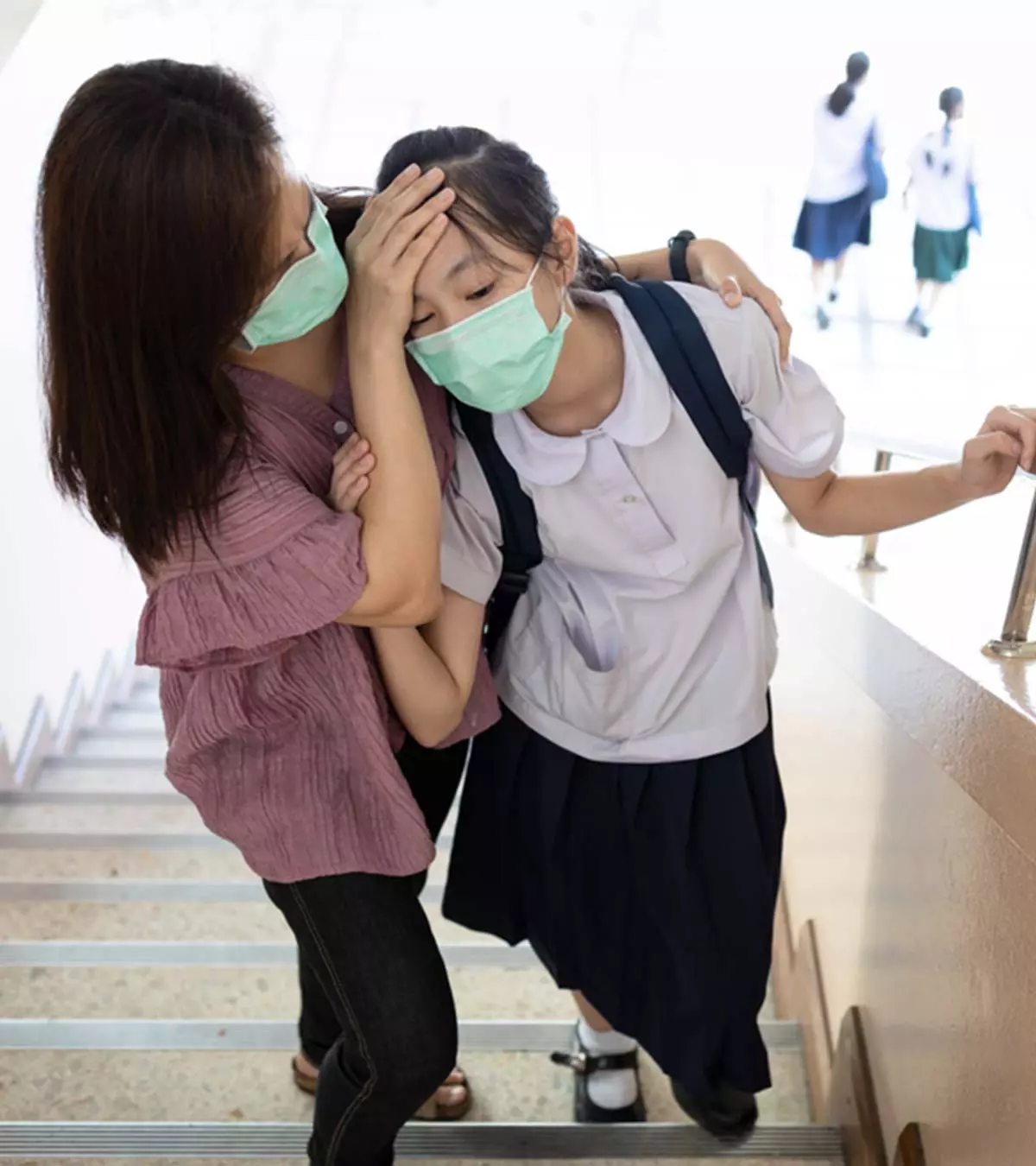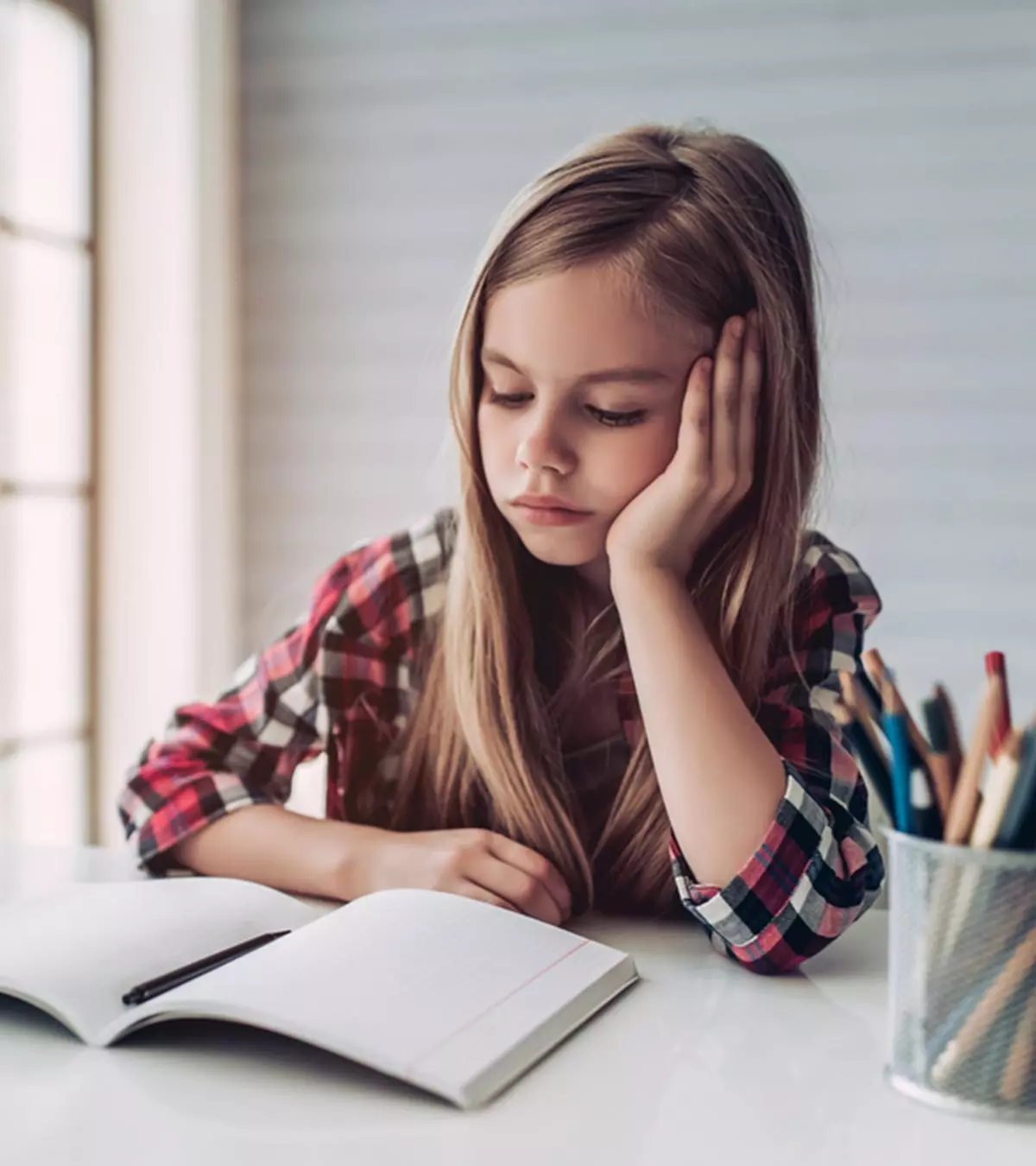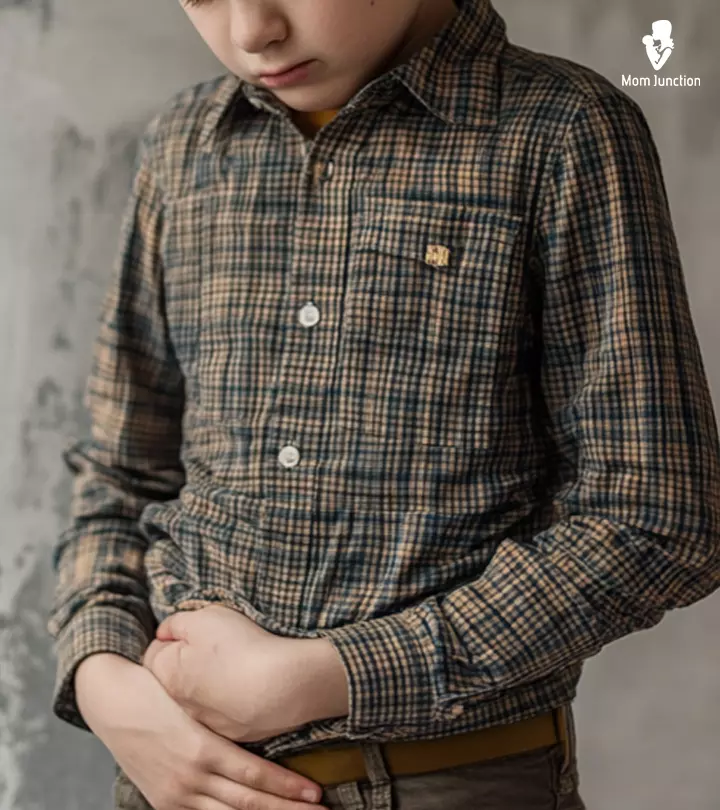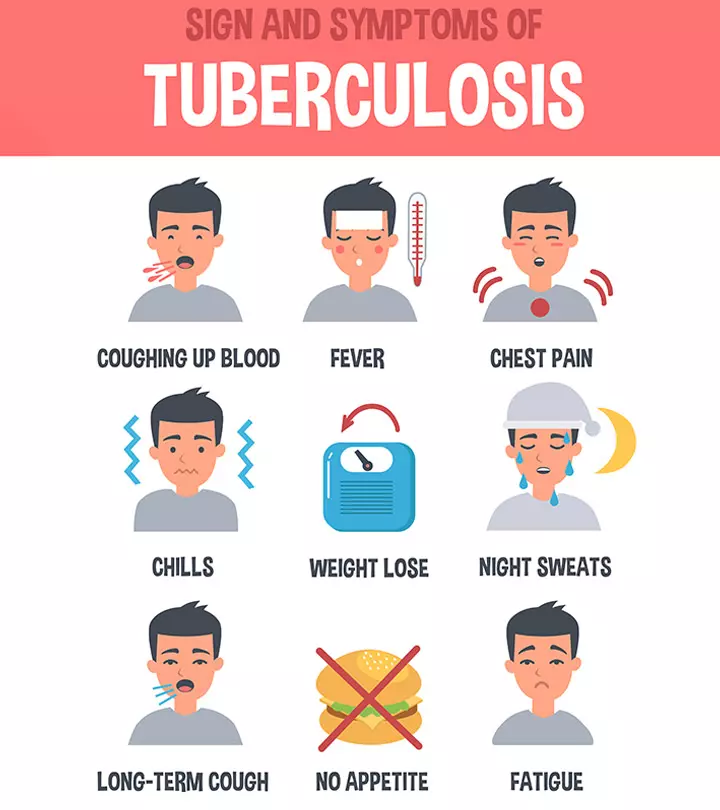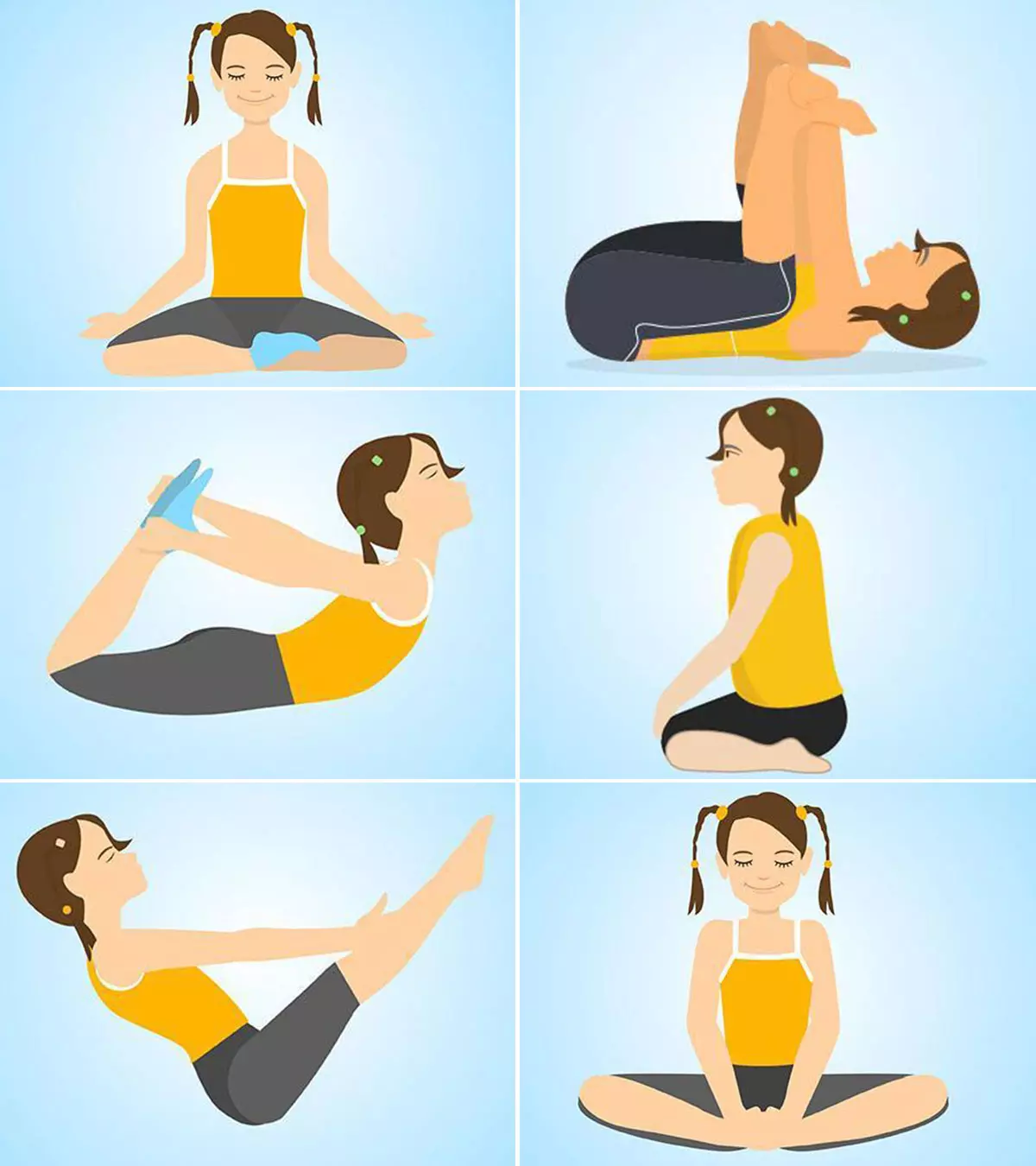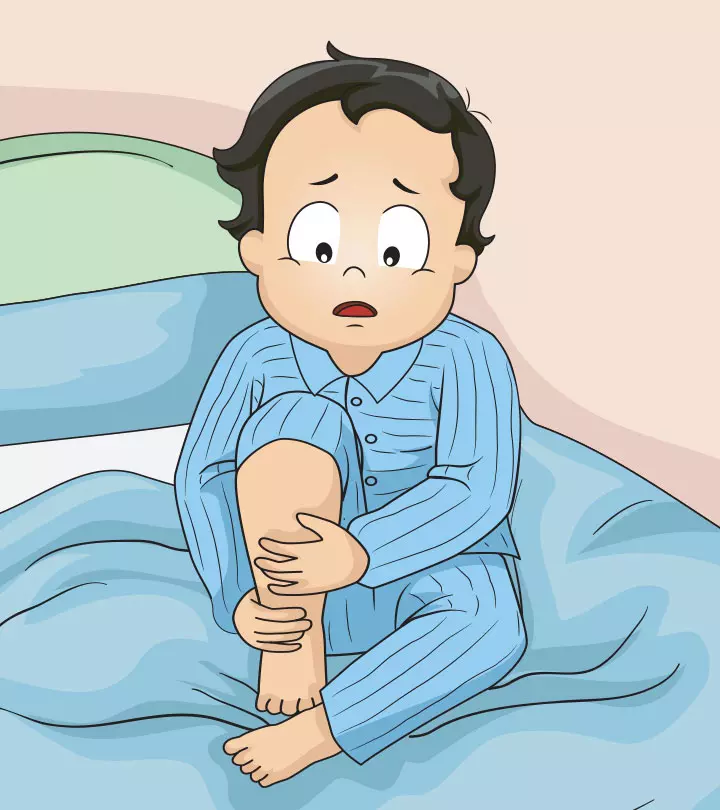
Image: Shutterstock

Growing pains in kids are cramps or pounding pains in the thighs, shins, calves, or back of the knees (1). They are often seen during childhood between three and 14 years, mostly in children who are physically active and have flexible joints. Although harmless and a natural part of development, growing pains in children can be troublesome at times (2).
Read through to understand the causes, symptoms, and treatments for growing pains in children.
Key Pointers
- Muscle tiredness, poor posture, low levels of vitamin D, and emotional issues are the causes of growing pains in children.
- OTC medicines, physiotherapy, and psychotherapy may help manage this condition.
Symptoms Of Growing Pains In Children
Muscular pain in the legs is the most common symptom of growing pains in children. The pain may affect both legs, and the child may experience the following additional symptoms (3).
- The leg pain comes and goes and occurs daily or occasionally.
- The leg pain may begin in the afternoon, evening, or around bedtime.
- The leg pain disappears in the morning.
- The leg pain can be severe and wake up a child from sleep.
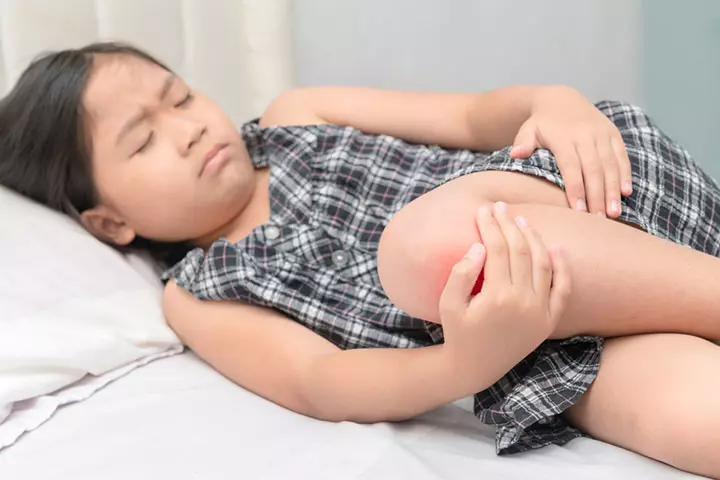
Image: Shutterstock
- The leg pain may occasionally affect the muscles of the arms as well.
- The leg pain may be accompanied by headaches.
Note: Despite what the name suggests, growing pains do not occur due to rapid growth during the adolescent growth spurt. Also, the pain affects the child’s muscles and not the joints, and hence, they can bend, walk, run, and play normally.
The intensity and frequency of growing pains vary from one child to another. Some children may experience pain daily, while others may not. Also, some may experience severe pain, while others may not feel much pain.
Causes Of Growing Pains In Children
The exact cause of growing pains is not known. However, experts believe that the following could be the probable reasons for growing pains in children (1) (3).
- Muscle tiredness: Indulging in more physical activity than usual may cause muscle aches in some children. However, this isn’t the case with every child. Some children may engage in a lot of physical activity at school or during playtime and still not experience any pains.
- Poor posture: Maintaining proper posture while standing, sitting, and walking is essential. If a child doesn’t maintain posture, it may strain the body muscles and cause aches. Also, children with flat feet and knock knees may often experience muscle cramps or pains.
- Low vitamin D levels: Vitamin D is an essential nutrient required to perform several functions, including calcium absorption and bone and muscle growth. A pooled analysis conducted by multiple institutes sought to ascertain the prevalence of vitamin D deficiency in children. The findings revealed that approximately 48.5% of children under 18 had insufficient vitamin D levels in their blood, falling below the 50 nmol/L threshold. If a child has low vitamin D levels, their bones can weaken, leading to aches and pains.
- Emotional issues: Some children may feel aches and pains due to anxiety and stress, sometimes induced by hormonal changes. However, all those children who have stress don’t get pain and aches.
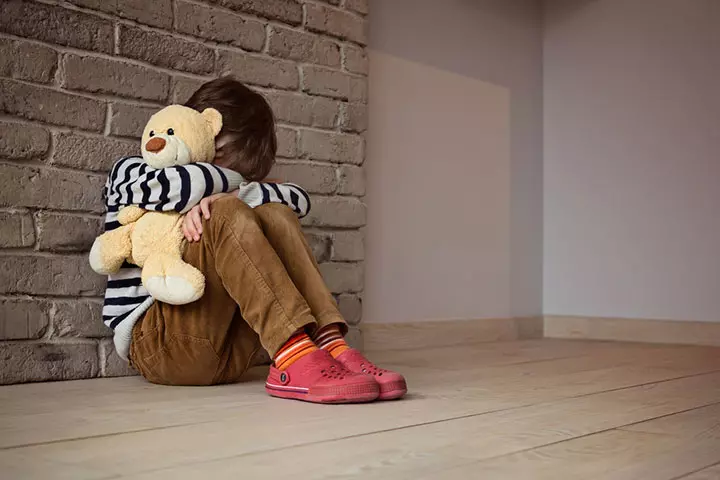
Image: Shutterstock
Besides these, some studies show that children with growing pains have more tender points and a low pain threshold than other children. It indicates that growing pains may be a variant of a non-inflammatory pain syndrome, especially in younger children (4).
Note: Unless growing pains affect a child’s daily functioning, they aren’t a cause for concern. According to the American College of Rheumatology, “Growing pains are the most common cause of musculoskeletal pain in children. Up to 50% of children can experience growing pains (1).”
How Are Growing Pains Diagnosed?
There are no specific tests to diagnose growing pains in children. Generally, the child’s symptoms, medical history, and physical exam help make a diagnosis. Besides, the doctor may ask you how long the child has been experiencing the pains and if the child has pain in one leg or both.
The doctor may order some laboratory or imaging tests, such as an X-ray or MRI, to rule out other health issues. Some of the symptoms that may indicate that your child has health issues other than growing pains include (1)
- Continuous and increasing pain.
- Pain stays in the same location.
- Stiff joints in the mornings.
- Swelling or redness over a specific area.

Image: Shutterstock
- Limping.
A few health conditions that can cause leg pains in children are arthritisiA bone disorder caused due to reduced bone density leading to inflammation, stiffness, and pain in joints , osteomyelitisiA bacterial infection that causes painful swelling of bones (bacterial infection), and Ross River infectioniA viral infection transmitted by infected mosquitoes and causes joint pain and swelling, fever, and rash (viral infection)
(3).
Note: Growing pains can be painful enough to wake a child in the middle of the night, making them feel sleepy the next day. Hence, prompt steps are necessary to help a child manage the pain and have a peaceful sleep.
How Long Does Growing Pains Last?
Growing pains may last for months or even years in children. The pain episodes may be weeks or months apart. However, for some children, it may occur daily. Each pain episode may last anywhere between a few minutes to several hours, and the pattern varies from one child to the other. The condition usually resolves mid-adolescence for most children (5) (6).
How To Treat Growing Pains In Children?
Since the cause of growing pains is unknown, the treatment is aimed at providing symptomatic relief to the child. Generally, the treatment course is individualized and may entail treatment modalities, such as (1) (7)
- Physical therapy: The doctor may ask you to massage the affected area daily, especially at bedtime, to help the child sleep peacefully. Massaging also aids in stretching the muscles and improving strength in children with hypermobility. The doctor may also suggest home remedies, such as
- Asking the child to take periodic rests between strenuous activities.
- Applying a hot compress or heating pad to the affected area.
- Taking a warm bath before bedtime.

Image: Shutterstock
- Wearing supportive shoes during the day.
- Over-the-counter (OTC) medications: Some children may feel extreme pain at night, which can affect their sleep. Thus, the doctor may prescribe an OTC painkiller for kids, such as ibuprofen, acetaminophen, or naproxen for recovery. These medications alleviate inflammation in the joints and muscles, and hence, reduce the pain. Note: Do not give aspirin, a non-steroidal anti-inflammatory drug (NSAID), to children under 16 years unless the doctor suggests (2).
 Things to know
Things to know- Psychotherapy: Chronic pain can disturb a child’s mental peace and put them under stress. This may cause some children to develop behavioral issues, such as irritability. Hence, a doctor could advise involving such children in counseling sessions to teach them positive pain coping strategies, such as deep breathing, guided imagery, and meditation.
The doctor may recommend orthotics (shoe inserts) for children with leg pains due to flat feet.
When To See A Doctor?

Image: Shutterstock
The following signs and symptoms may indicate that your child’s aches aren’t due to growing pains. Instead, they could be due to an infection or injury (2) (7).
- Extreme pain in both or one leg
- Persistent pain during the day
- Pain begins at night and continues to the next day
- Pain in the joints, such as ankle and knees
- Bruising, swelling, or rash on the legs that do not improve within 24 hours despite using home remedies, such as cold packs or compresses
- Reddening or increased warmth in the leg muscles
- Limping due to severe pain
- Soreness on one or both legs
- Fever and feeling of malaiseiA general feeling of illness, weakness, or discomfort
- Loss of appetite
 Research finds
Research findsSeek your child’s pediatrician promptly if your child has any of these symptoms.
Frequently Asked Questions
1. Do growing pains mean my child is getting taller?
No conclusive evidence exists to demonstrate that growing pains are related to vertical growth (5). Although growing pains are commonly associated with growth spurts in children during early adolescence or puberty, no causal relationship has been found between the two.
2. How long does an episode of growing pains last?
Some children may experience pain for minutes and others for several hours while growing up. In some children, the pain may occur daily, while for others, it may occur intermittently, with pain-free intervals of days, weeks, and even months (5).
3. How can parents help their children feel better?
Growing pains can’t be prevented. However, you and other members of the family can encourage and support your child to take frequent breaks when physically active to give their legs some rest. Enroll them in different activities and sports that engage different muscles. Additionally, give your child a warm bath before bedtime and massage their aching muscles. Furthermore, you can place heating pads on the areas where your child’s leg hurts the most (5) (8).
4. Do Epsom salts help with growing pains?
Epsom salt has been used for ages to relax muscles and alleviate pain in the skull, neck, shoulder, and back (9). You may try using Epsom salt to soothe your child’s aching leg muscles after consulting an expert in alternative medicine. They can guide you on the best Epsom salt-to-water ratio to help your child reap the solution’s benefits.
5. Are growing pains genetic?
According to a 2019 study, a family history of growing pains has been documented in many studies, and it seems to be a risk factor in the etiology of growing pains. However, no conclusive studies were found to validate that growing pains are genetic (10).
6. What is the outlook for growing pains?
Growing pains make your child feel uncomfortable but they do not have any long-term serious health implications. However, frequent episodes of growing pains may disrupt your child’s day-to-day routine by causing fatigue, missed school days, and reduced physical activity (5).
Growing pains in kids are pains or aches in the muscles usually seen in physically active kids and those with flexible joints. The discomfort intensity varies from child to child and may be caused by muscle fatigue from physical exercise, poor body postures, low vitamin D levels, or anxiety or stress. While most children with growing pains do not have any functional or growth concerns, the condition may cause discomfort in some, necessitating medical attention. However, most respond well to treatment and grow out of their condition with time and maturation.
Infographic: Indicators Of Children’s Growing Pains
If your children have been complaining about leg pain, you may be wondering if it’s normal or something different. The following infographic lists the typical signs of growing pains. By gaining knowledge about these signs, you can assist your child in feeling better and ensuring their healthy growth.
Some thing wrong with infographic shortcode. please verify shortcode syntaxIllustration: Causes And Symptoms Of Growing Pains In Children
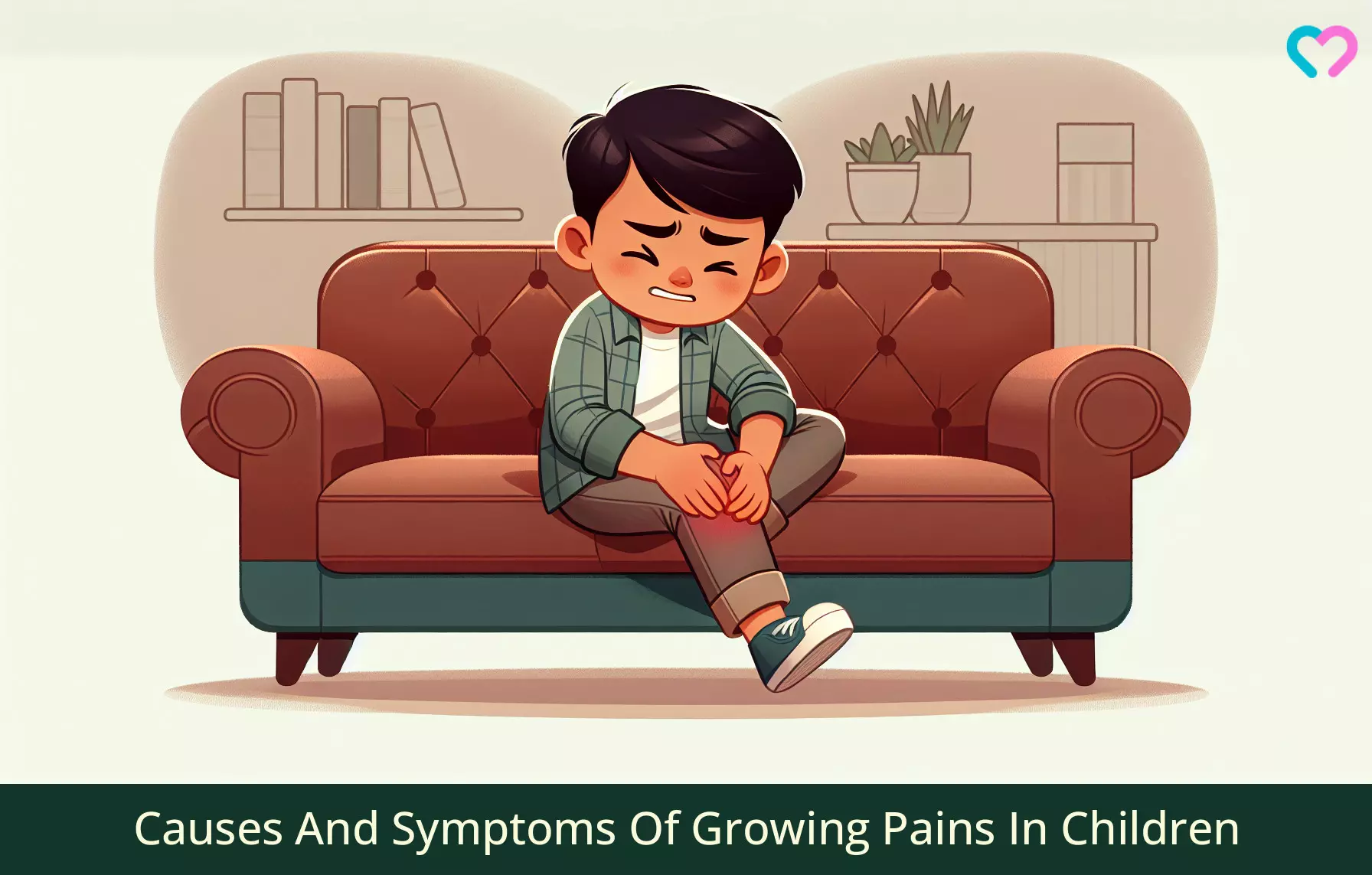
Image: Dall·E/MomJunction Design Team
References
- Growing Pains.
https://rheumatology.org/I-Am-A/Patient-Caregiver/Diseases-Conditions/Living-Well-with-Rheumatic-Disease/Growing-Pains - Growing pains.
https://www.nhs.uk/conditions/growing-pains/ - Growing pains.
https://www.betterhealth.vic.gov.au/health/healthyliving/growing-pains - Growing Pains.
https://familydoctor.org/condition/growing-pains/ - Growing Pains.
https://my.clevelandclinic.org/health/diseases/13019-growing-pains - Growing Pains.
https://kidshealth.org/en/parents/growing-pains.html#:~:text - Growing Pains Are Normal Most Of The Time.
https://www.healthychildren.org/English/health-issues/conditions/orthopedic/Pages/Growing-Pains-Are-Normal-Most-Of-The-Time.aspx - What a Pain! Kids and Growing Pains.
https://kidshealth.org/en/kids/growing-pains.html - Should You Take an Epsom Salt Bath?.
https://health.clevelandclinic.org/7-things-you-probably-didnt-know-about-epsom-salt - Vito Pavone et al.; (2019); Growing pains: What do we know about etiology? A systematic review.
https://www.ncbi.nlm.nih.gov/pmc/articles/PMC6475815/ - V. Pavone et al.; Growing Pains: A Study of 30 Cases and a Review of the Literature
https://www.semanticscholar.org/paper/Growing-Pains%3A-A-Study-of-30-Cases-and-a-Review-of-Pavone-Lionetti/6d44d5b987a2841c955c4e59baaabd662578ad05 - S. Rajaram et al.; Some children with growing pains may actually have restless legs syndrome
https://www.semanticscholar.org/paper/Some-children-with-growing-pains-may-actually-have-Rajaram-Walters/885490af60bb0615890cffd0fc56eb8dedc8921c
Community Experiences
Join the conversation and become a part of our nurturing community! Share your stories, experiences, and insights to connect with fellow parents.
Read full bio of Dr. Dur Afshar Agha
Read full bio of Swati Patwal
Read full bio of Rohit Garoo
Read full bio of Dr. Joyani Das






